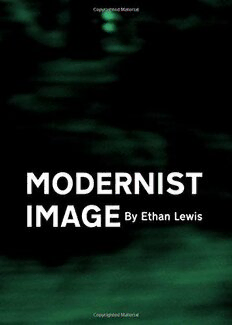
Modernist image PDF
Preview Modernist image
Modernist Image Modernist Image By Ethan Lewis Modernist Image, by Ethan Lewis This book first published 2010 Cambridge Scholars Publishing 12 Back Chapman Street, Newcastle upon Tyne, NE6 2XX, UK British Library Cataloguing in Publication Data A catalogue record for this book is available from the British Library Copyright © 2010 by Ethan Lewis All rights for this book reserved. No part of this book may be reproduced, stored in a retrieval system, or transmitted, in any form or by any means, electronic, mechanical, photocopying, recording or otherwise, without the prior permission of the copyright owner. ISBN (10): 1-4438-2232-9, ISBN (13): 978-1-4438-2232-9 In Memoriam: Razak Dahmane Robert McElroy Hammed Shahidian “Lordly men…to earth o’ergiven” TABLE OF CONTENTS Foreword....................................................................................................ix Ben Lockerd Preface .....................................................................................................xiii Chapter One.................................................................................................1 Super-Position: Interpretive Metaphor Chapter Two..............................................................................................49 Imagist Technique in the Cantos Chapter Three............................................................................................87 Eliot as ‘Imagist’ Chapter Four............................................................................................145 Four Quartets as Discursive Image: Metaphysics and Mechanics Afterword................................................................................................169 Appendix.................................................................................................177 Grammaria Usurae: Representational Stratgems in Canto XLV Works Consulted.....................................................................................183 Index........................................................................................................189 FOREWORD The history of Western thought may be seen (meaningfully, even if somewhat simply) as a shift from objectivity to subjectivity, and poetry reflects this transformation. The Iliad is entirely objective, focused on the external world of sea and plain, walls and weapons. There is not internal monologue recorded in the entire poem: every thought the reader knows about is spoken aloud by the character. Even the gods move entirely in the outer world, communicating with mortals exclusively by appearing physically to them and speaking aloud, grabbing them, or knocking them down. By the time of Virgil, the hero begins to have subjective experiences, a few (but very few) moments of inward cogitation. A balance of subjective and objective experience is hit in Dante’s Comedia, where the hero is the poet himself and the action is a spiritual transformation, but where that inner action corresponds at every point to an experience of a literal, physical other world in which even the blessed are embodied and the human face is united in the final lines with the divine circle of light. By the time of Wordsworth’s Prelude, nearly the entire poem records the subjective experience of the poet, while the external experiences of nature and other people tend to dissolve into his meditations. This transition from ancient objectivity to modern subjectivity is what Yeats traces in the complex historical system of A Vision. It is also what Schiller is addressing when he makes his famous distinction between “naive” and “sentimental” poetry: he allows that some modern writers (notably Goethe) are of the naive type, but it is clear that he supposes sentimental poetry (with all its intense self-consciousness) to be the characteristic mode of the modern world. M. H. Abrams identifies the same dichotomy and the same historical shift with his well-known terminology: the ancients thought of poetry as essentially “mimetic,” descriptive of the external world; from the Romantics on, it came to be seen as essentially “expressive,” pouring forth the mind of the poet. In the late nineteenth and early twentieth centuries, subject and object tended to separate entirely, with an apparently unbridgeable chasm between. A new sort of objectivity appeared as some thinkers took a radically materialist approach. Various scientistic ideas (such as logical positivism) exemplify this pole of the modern duality. Two objectivist
